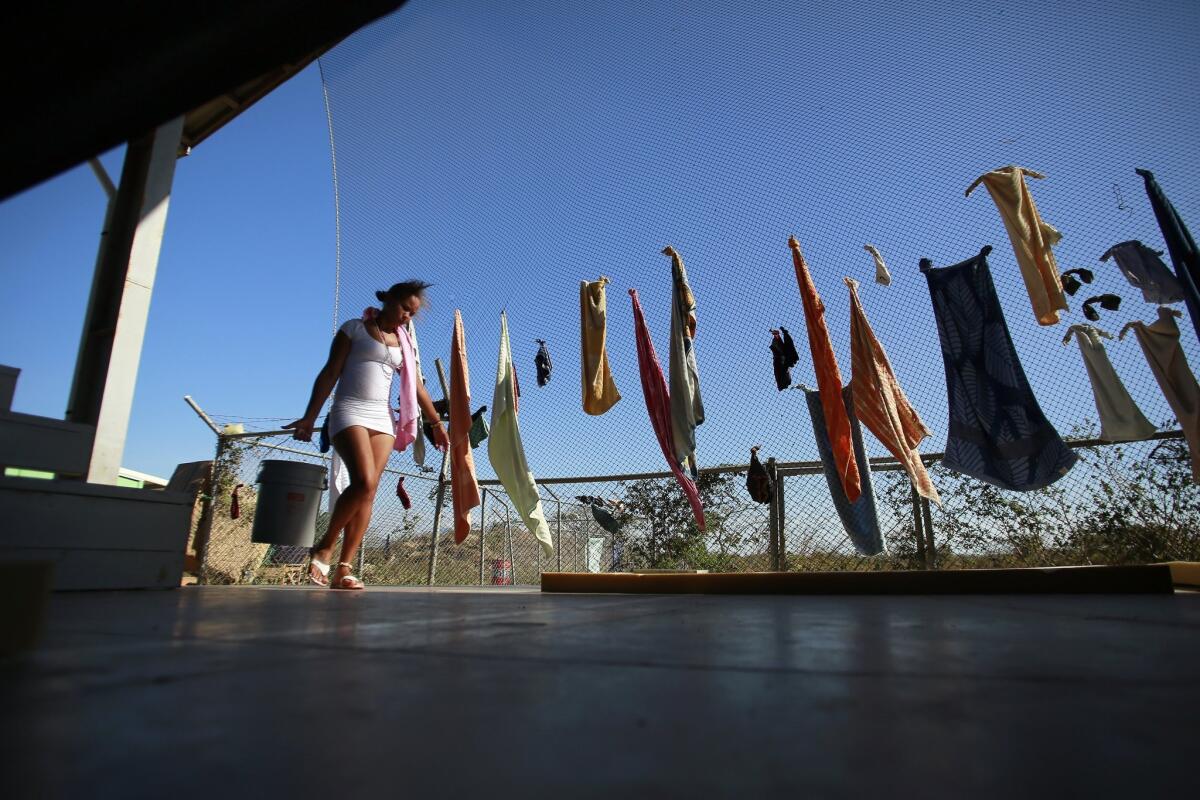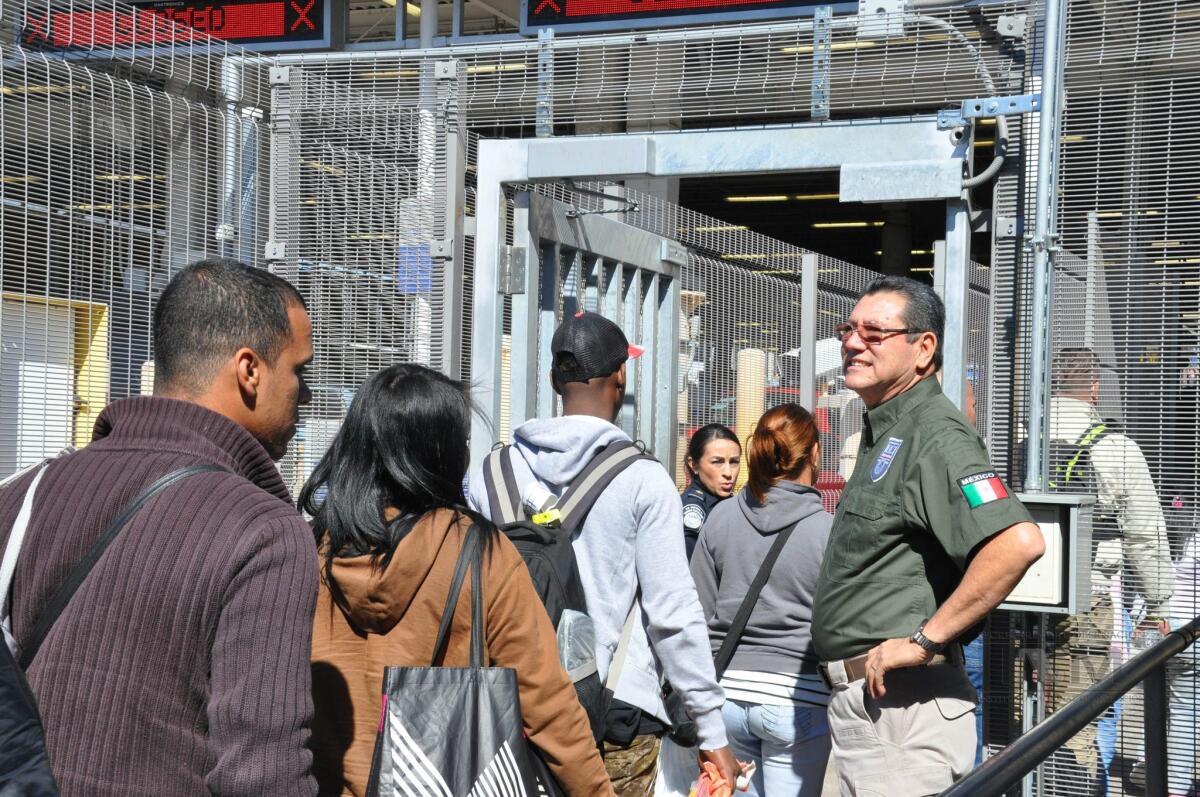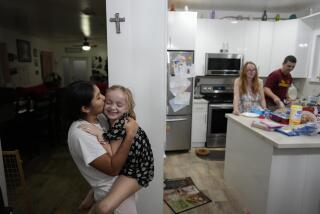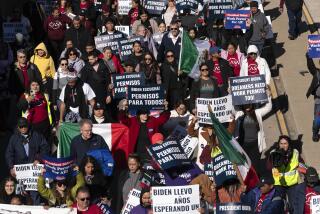Unlike other migrants, Cubans get welfare benefits and shot at citizenship
Scores of Cubans crossed the border bridge here from Mexico on a recent week day, pregnant women in fluorescent rhinestone-studded T-shirts, men in tight jeans towing suitcases – all in search of Alejandro Ruiz.
Many of the migrants find Ruiz via his cellphone or by navigating his Facebook page. But on this day, those searching for Ruiz came up empty when they reached his storefront office. He was on the other side of town, busy helping new arrivals at one of two temporary shelters he operates.
Ruiz, 49, a Cuban American auto body shop owner, noticed the need here years ago as the influx was just starting. He encountered Cuban migrants at the border checkpoint who seemed to have no idea what to do once they stepped into America, the same overwhelming feeling he had when he flew from Havana to New Jersey in 1992. Back then, a Cuban women’s group helped him navigate the system.

Alejandro Ruiz, in tie, at one of the homes he runs for newly arrived Cuban migrants.
Now a citizen, Ruiz founded Cubanos en Libertad, a nonprofit that provides transportation, shelter and assistance to Cuban migrants.
The number of Cubans arriving in the U.S. has steadily increased since 2009 but nearly doubled in the fiscal year that ended in September to more than 43,000, according to U.S. Customs and Border Protection.
At Ruiz’s transit shelter, a white corner house on a run-down stretch of Hidalgo Street near the San Augustin de Laredo historic district, new arrivals chatted in rapid-fire Cuban Spanish in a rear courtyard. On the living room couch, next to a pile of luggage, teenagers listened to “Dos Copas de Mas,” by the pop duo Ha*Ash, on Spanish-language radio on their cellphones. In a darkened back bedroom, two women slept.
In the kitchen, a cook served Cuban fricasé de pollo, stewed chicken and potatoes with black beans on rice, and a desert of dulce de toronja, candied grapefruit rind sprinkled with Mexican white cheese.
“I only help the people who don’t have money. I have a little house, and I help them get documents,” Ruiz said as he sat down at the kitchen table for lunch.
Of course, it’s more complicated than that.
Thanks to the Cuban Adjustment Act of 1966, Cubans who arrive in America are granted permission to stay legally. Unlike the tens of thousands of Central Americans who have poured into south Texas in recent years, the immigrants from Cuba are also eligible for federal welfare benefits and permanent residency, a path to citizenship.
But as relations between the U.S. and Cuba began to normalize in 2014, thousands fled toward America, afraid their window of opportunity would close.
Most of the Cuban migrants fly to Ecuador, then travel north through Central America and Mexico to this Texas border town. It’s a longer trip than the traditional overseas route to Florida but considered a better bet.
I want it to be free.
— Janey Saque, speaking of her unborn child
Once they arrive, Ruiz – a heavyset man with gray hair and a goatee -- is there to help. He provides temporary shelter and arranges drivers and vans to ferry many of the new arrivals to Miami, a top destination. Others stay for months at one of the houses while he helps them get Social Security numbers, food stamps, work permits, Medicaid and other benefits.
“Then when they get their permit for work I say, ‘You’re on your own!,” Ruiz said.
Many arrive hoping to join relatives, some of whom came during past mass migrations.
Those who don’t go to Cuban enclaves in Florida migrate to Houston, Los Angeles, Las Vegas or Louisville, Ky. -- the last the home to a host of immigrant resettlement groups. Others go to New Jersey or to Omaha and slaughterhouses that are hiring.
About 600 arrived last weekend, and more than 100 more were expected soon, Ruiz said, clicking through emails on his smartphone. A friend was emailing him updates from Costa Rica, where an estimated 8,000 Cuban migrants have been stranded since late last year after Nicaragua closed its border.

A Cuban migrant carries a bucket of water at a temporary shelter in La Cruz, Costa Rica.
Central American leaders announced a deal last month that allowed the stranded Cubans to fly from Costa Rica to El Salvador, then travel by bus to the border – for $550. On Tuesday, officials added the first direct flight to Laredo’s sister city, Nuevo Laredo.
But many of the migrants Ruiz was aiding were not on that plane.
“When they said they were going to have only two flights per week, the Cubans said we will be here another six months! So they contacted coyotes to cross,” Ruiz said, adding to the influx here.
One of them was Ernesto Rosales, 23, a barber with rhinestone studs in his ears who fled Matanzas, Cuba, in early December, leaving behind his mother and 18-year-old brother. After landing in Ecuador, he traveled to Costa Rica, where he was stuck for months, working as a barber.

A handout photo released by National Institute of Migration shows a group of Cubans crossing a border passage between Nuevo Laredo into the U.S.
When Rosales heard about the new flight limits, he knew it was time to go. He paid a coyote $650 to get him to Honduras, another $300 to reach southern Mexico.
“I didn’t want to be stuck another five months,” he said.
Next week, Rosales and three other men will go with Ruiz to get Social Security cards, Medicaid and food stamps.
Rosales plans to find work as a barber in Miami or New Jersey, become a citizen and bring the rest of his family to America
Sulen Marrero, a 15-year-old bottle blond wearing a pink tank top, also turned to a coyote after spending three months stuck with her mother and 27-year-old sister in Costa Rica, living in a partitioned room with more than 100 others and working as a stylist. Now they’re headed to Miami to join her stepfather.
Marrero recalled the most dangerous part of the trip was traveling through Columbia, where she saw armed men in the streets.
“There were some others who got kidnapped, robbed. They just want money. If you don’t give it, they kill you,” she said.
Another migrant, one of the first passengers from the Costa Rica flight, is six months pregnant and said she has yet to see a doctor.
“I want it to be free,” Janey Saque, 27, said of her unborn baby.
Saque said she spent three months in Costa Rica and that she and her mechanic husband paid $38,000 for the trip after leaving Havana.
On the plane with them from Costa Rica were about 40 other pregnant women, she said.
That worried Ruiz. He has been trying to get the government to provide more assistance here and in Florida, where at least one lawmaker has proposed a job training and placement program for them. Tomorrow he is meeting with officials from a local Methodist church who may help.
“If more people start coming,” Ruiz said, “we are going to be in trouble.”
More to Read
Start your day right
Sign up for Essential California for news, features and recommendations from the L.A. Times and beyond in your inbox six days a week.
You may occasionally receive promotional content from the Los Angeles Times.







